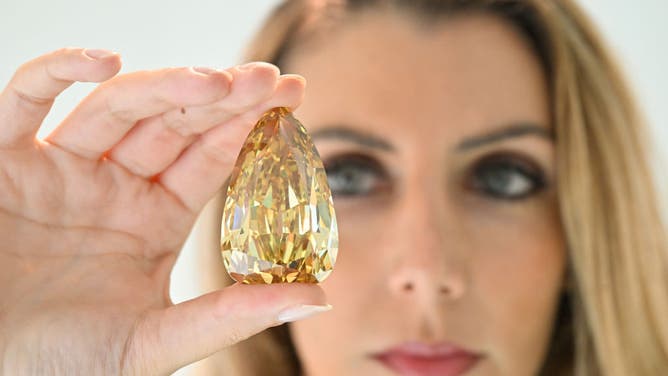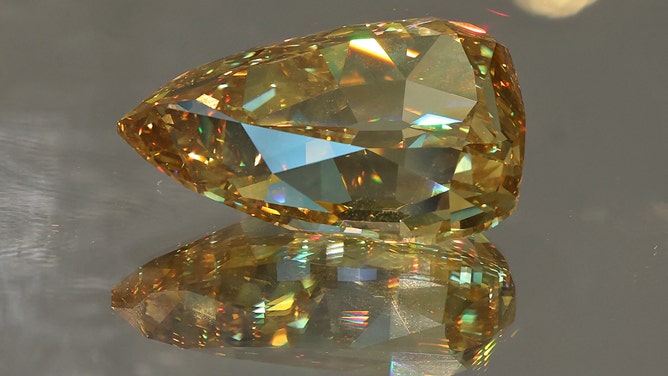What one rock endured to become the largest, flawless diamond in the world
Heat and pressure, difficult to comprehend here on the Earth's surface, morph one of the planet's most abundant elements into a costly gem. The Sotheby's Auction House gave the world a peek at the sparkle recently.
Sotheby's unveils the world's largest internally flawless diamond
Sotheby's Dubai unveiled the Golden Canary, the largest flawless diamond in the world, certified by GIA. The stone will take a world tour before hitting the auction block on December 7, 2022, in New York.
The world’s largest and internally flawless diamond hits the auction block in December, just in time for a Christmas gift.
Many of us may think that the $15 million price estimate would be the biggest obstacle between you and the Golden Canary diamond. But no, that 303-carat diamond had a battle just to get to the surface.
A diamond's ‘weather’ versus a human's weather
Let's compare human environments to a diamond’s. Meteorologists focus on the atmosphere above ground, and diamonds are formed below ground.
Heat and pressure force carbon atoms to bond in a cubic crystal structure deep beneath the earth. By the time a diamond graces a finger or crown, it is at least 990 million years old, according to the University of California's "Gem and Gem Materials." Scientists can’t measure the gem with carbon dating because the carbon is too old and turn to radioactive decay, wrote the Gemological Institute of America.
‘FRANKENSTONE’ UNEARTHED: MAN'S LARGE DIAMOND FIND TOPS RECORDS AT ARKANSAS PARK

The diamond will be auctioned at Sotheby’s New York on 7 December, with an estimate in the region of $15 million.
(Cedric Ribeiro / Getty Images)
Heat
Meteorologists talk about heat waves around 100 degrees Fahrenheit, moms caution us about ‘scalding hot’ boiling water at 212 degrees Fahrenheit and pizza ovens are an unimaginable 700-800 degrees hot. The birthplace of a diamond ranges from 1,600 to 2,300 degrees Fahrenheit, according to the class notes.
Pressure
The average pressure at sea level is one atmosphere. But a diamond is formed between 44,000 and 60000 atmospheres. An average crusher needs about 136 atmospheres to crush a car, notes bestsellingcarsblog.com.
We can get a weather forecast anytime we would like on TV or the FOX Weather app. But diamonds need a volcano to see the light of day. That’s right, diamonds form in the earth's mantle and hitch a ride with volcanic magma. The pipeline is called a kimberlite pipe or a diamond pipe. Diamonds form between 90 and 120 miles below the surface.
CARATS AND RANCH: DIAMOND MADE FROM SALAD DRESSING HIGHLIGHTS LAB-GROWN POPULARITY

An estimated 5 to 7-carat diamond is just near an Angolan village not far from the Congolese border.
(Olivier Polet/Corbis / Getty Images)
Scientists estimate that the magma flows at 6 to 19 mph. The last mile to go, the speed may increase to a couple hundred miles per hour. Slower moving diamonds in the making, carbon crystals turn into graphite used to make pencils. Diamonds, the hardest mineral, are made of the same material that graphite, one of the softest minerals, is made from. Speed makes all the difference.
The four Cs
The Golden Canary is a pear-cut diamond. The GIA certified the diamond as internally flawless. We know 3 of the 4 ‘Cs’ cut, clarity and carat, but what about color, yellow?
Nitrogen introduced into the carbon crystal structure gives the diamond its yellow color. The more nitrogen trapped in the stone, the more vivid the color since nitrogen is an impurity. But Sotheby’s, the auction house putting the stone on the block in several weeks, writes that enough color puts the stone into a new category.
HOW TO WATCH FOX WEATHER ON TV

The "Golden Canary" brownish-yellow colored diamond, weighing 303.10 carats.
(GIUSEPPE CACACE/AFP / Getty Images)
"When there is a large amount of nitrogen present within the stone, the diamond ceases to become M-Z colored and becomes a fancy colored diamond," states the Sotheby’s jewely site. "As the color concentration increases within the stone, so does its value."
Don’t feel priced out of the auction. Bidding starts at just $1, and there is no reserve or minimum price that the seller will sell for.
History of the Golden Canary
The Natural Diamond Council writes on its website that this stone was previously the third-largest cut diamond in the world, called the Incomparable Diamond at 407 carats. It was the centerpiece of the most valuable necklace in the world, valued in 2013 at $55,000,000, according to the Guinness World Records. The owner had the diamond recut.
WHY DIAMOND DUST SPARKLES LIKE DIAMONDS IN THE SKY

The Incomparable Diamond was recut using state-of-the-art technology to become the Golden Canary. Here the Incomparable Diamond is set in the "most valuable necklace in the world," according to Guinness World Records. All the diamonds together equal 637 carats.
(ROSLAN RAHMAN/AFP / Getty Images)
A girl playing in her uncle’s backyard in the Democratic Republic of Congo in the 1980s found the raw diamond. The 890-carat uncut, rough diamond was cut into 15 separate stones, the report continued.
